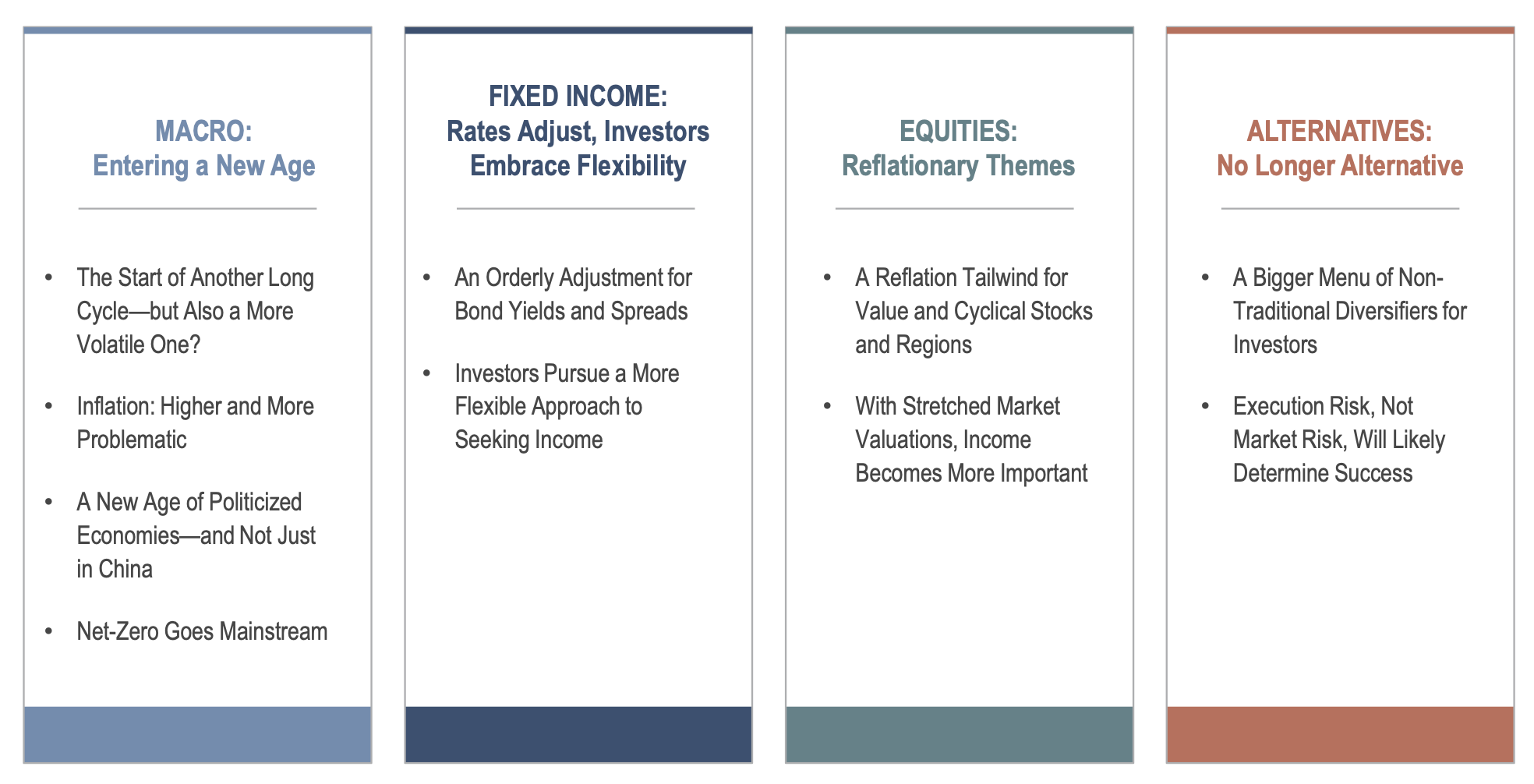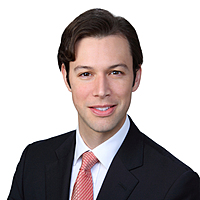Neuberger Berman's 10 investment themes for 2022
In Neuberger Berman's '10 for 2022', the leaders of our investment platforms gathered to talk about the evolution of the investment environment over the last twelve months and the key thematics they consider the most important for the year ahead.
As we move into another long cycle from the 'post-COVID phase', we expect higher inflation and government engagement to be key drivers of higher market volatility. After 40 years of declining inflation and interest rates, structural drivers in the energy transition and supply chain and labour pressures could tilt the balance to higher prices going forward.
Looking across investment platforms, we expect investors to embrace flexibility and diversify their approach to niche and non-traditional options across fixed income and alternatives to mitigate that inflation risk. Reflationary spending could provide a tailwind for value in cyclical equity stocks even as valuations remain stretched.
In this snippet of Neuberger Berman's 2021 conference, we've summarised the themes.

Macro: entering a new age
“How do central banks respond to this inflation? Their policy tools are less effective against supply bottlenecks or rising wages.” – Erik Knutzen
1. The start of another long cycle - but also a more volatile one?
We are moving from the recovery phase of the current cycle to its middle phase. But what kind of cycle is it likely to be? The previous cycle was the longest in history and it ended only due to the exogenous shock of the pandemic. If anything, we believe that the willingness of fiscal and monetary authorities to support the cycle is even greater today. Inflation and new redundancies built into supply chains could introduce more business-cycle and market volatility, but we think we could be in for another long expansion.
2. Inflation: higher and more problematic
After 40 years of declining inflation and interest rates, the direction of travel appears to be changing, due to new central bank policy priorities, China’s strategic reorientation, the energy transition, pressures in supply chains and labor’s increasing bargaining power in negotiations over the spoils of growth. The tilt toward supply-side, cost-push inflation in this dynamic will likely pose a challenge to central banks. How central banks choose to navigate a changing inflation environment will likely generate market volatility in the coming year.
3. A new age of politicised economies - and not just in China
China’s ongoing strategic reorientation of its economy explicitly elevates social and political objectives such as “common prosperity” and “internal circulation” over outright growth. But this is not just a China story. Worldwide, political and monetary authorities now have more tools, more capacity and more willingness to direct economic activity than ever before—in pursuit of climate, social equality, political, geopolitical and security goals, among many others. That likely means higher taxes. As the role of markets in resource allocation diminishes, we could also see more supply-and-demand mismatches, inflation and volatility.
4. Net-zero goes mainstream
The 26th United Nations Climate Change Conference of the Parties (COP26) wrapped up as our themes went to press. Many countries went into COP26 lagging in their commitments, but impetus appears to be growing. The European Union’s “Fit for 55” legislative agenda sets an aggressive standard. Just as important, the private sector is pressing ahead: we see critical mass in corporate net-zero pledges and plans, and in signatories to asset managers and asset owners’ net-zero initiatives. It will become increasingly imprudent in our view to ignore climate and climate policy risks in portfolios.
Fixed income: rates adjust, investors embrace flexibility
“We believe a mix of these short-duration, less-correlated and tactical sources of income is likely to pay dividends in the year ahead.” – Brad Tank
5. An orderly adjustment for bond yields and spreads
Core government bond yields remain low, particularly relative to current inflation; and credit spreads, in our opinion, are priced for perfection. We think the direction of travel in 2022 is up and wider, respectively. Finding income with modest or no duration will continue to be the priority, in our view, but major market disruption or significant credit issues appear unlikely. We believe a more tactical fixed income investment environment is developing.
6. Investors pursue a flexible approach to seeking income
Faced with a combination of low and rising rates and tight credit spreads, investors are likely to double down on their search for short duration, floating rate, and less correlated sources of income. They may complement this with more tactical positioning, whether that be in interest rate risk exposure, asset allocation or into narrower, niche, but attractive markets. The opportunities likely to draw attention range from short duration credit, loans and collateralised loan obligations (CLOs) to China bonds and European corporate hybrid securities. We believe a mix of these short-duration, less-correlated and tactical sources of income could pay dividends in the year ahead.
Equities: reflationary themes
“For really attractive opportunities, we think the value style is more interesting, and especially equity income as a subset of value.” – Joseph Amato
7. A relation tailwind for value and cyclical stocks and regions
We think inflationary expansion is likely to support cyclical over defensive sectors, value over growth stocks, smaller over larger companies and non-U.S. over U.S. markets. That pattern was interrupted after Treasury yields hit their peak in March 2021, but could reassert itself as yields start to edge up again—particularly if this is accompanied by a weaker U.S. dollar. This environment would normally bode well for emerging markets, but substantial headwinds mean we tend to favor only specific opportunities, such as leading companies in India’s innovation sectors.
8. With stretched market valuations, income becomes more important
The story of value underperformance is well known. But income, as a subset of value, has fared even worse over the past decade. There are three sources of equity returns: multiple expansion, earnings growth and compounded dividend income. Multiples appear stretched, and earnings have been growing above trend—which suggests to us that income may be more reliable over the coming year. Over the past 50 years, income has accounted for around 30% of equity total returns. Moreover, in an inflationary environment with low but rising rates, equity income is also a way to get short duration and inflation exposure into portfolios at relatively attractive valuations.
Alternatives: no longer alternative
“There are two key reasons to consider private markets right now. First, it’s an abundant source of opportunistic investments. Second, execution risk, not market risk, is most likely to determine success." – Anthony Tutrone
9. A bigger menu of non-traditional diversifiers for investors
Investors face high valuations in many growth markets, combined with rising yields and diminished diversification benefits from core bonds, and the potential for inflation running above recent trend levels. This appears likely to encourage all types of investor to make larger, more diverse allocations to alternatives, liquid and illiquid, as well as assets that can mitigate the impact of transitory and secular inflation, such as commodities and real estate. Individual investors may have the ability to make the most notable move, as private equity and debt products become more accessible to them.
10. Execution risk, not market risk, will likely determine success
Valuations are high in current private equity deals. However, while starting valuation can be a strong determinant of long-term public equity returns, the relationship has not been so strong in private markets. We think that could be especially true with today’s deals, from venture to buyout. Whereas historical vintages often relied on buying cheap and applying leverage, we see that today’s average deal is comprised of more than 50% equity, and depends on its potential returns on successful operational and strategic enhancements, and merger-and-acquisition (M&A) “roll-up” programs.
Their complete conference report is available here.
Would you like first access to my wires ahead of my trip in March
In the build up to my upcoming visit in March this year, my next wire will zoom in on the fixed income market outlook and how we are positioning for the current macroeconomic environment. Please click 'FOLLOW' below for first access to my insights in the build up to my trip.

5 topics
1 fund mentioned

